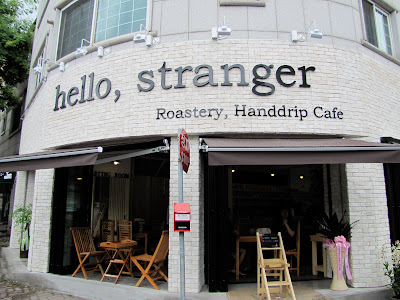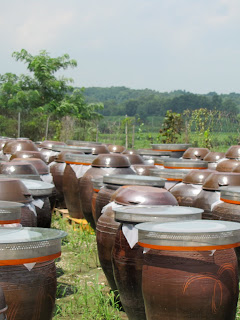Last week I participated in the
G-20 WWOOF program at Handemay Village near the town of Danyang (
단양). To say the least, my experience was amazing and I can't wait to try my hand at WWOOFing again. (For more information about wwoof in general, click
here)
The G-20 program, which is sponsored by the Ministry for Food, Agriculture, Forestry & Fisheries of Korea and the Korea Rural Community Corporation, is open to any foreigner visiting or residing in Korea free of charge until the end of the year. With the G-20, participants get to do more than just farming; they get a cultural immersion of rural life in Korea.
Unfortunately, since I had to go back to work on Monday, I did not get to complete the program and because of that my experience may be a bit skewed, though certainly not discredited.
Day 1 (Wednesday):
I arrived at the WWOOF Korea office at 1pm to begin the program. I had no idea how many other people would also be in the program and where they would be from. I admit that I thought there would only be one or two other people, but to my delight I was able to meet 7+ volunteers from all over the world! As expected, there were a few teachers like myself from Canada and the United States, but I also met a girl from Hong Kong, a guy from Norway, and a guy from Germany by way of Australia.

After everyone had registered we all walked to the nearby
hanok, a traditional Korean house. When you stay at a hanok you must sleep on the floor, but after staying in so many pensions and minbak's this past year, I have gotten used to it. Most people find that sleeping on the floor for a night is refreshing and does good things for their back and posture.
That afternoon we went on a walking tour of the
Insadong area of Seoul. Though of course I had been to the main street of Insadong many times, we took the path less traveled and explored areas I would otherwise had never seen.
We also got to meet a man who our tour-guide claimed was one of the most famous traditional Korean window carpenters in the whole world. He is even on television for his talent! Also, this man is "super busy, so super busy," so we were lucky in that regard as well.
The carpenter; his tools; and his workshop.
After our walking tour we got to take a Korean cooking class. Yes! This is something that I have wanted to do since I came here and I was thrilled to be able to finally do it. Because of the G-20 program the cooking class cost us just w5,000 ($4.39 by today's exchange rate) instead of the w70,000 ($60) it would normally cost!
We learned how to make
naengmyeon, a typical summer dish made from buckwheat noodles served in a cold broth and
bulgogi, a marinated beef dish. The food was delicious (bonus points for having two non-spicy foods in one sitting!) and we even got some cookbooks so that we could make the food again and again.
Ingredients for naengmyeon; cooking away; the finished product.
The whole group; overlooking Seoul; snazzy me in a Hanbok and apron.
When we returned to our Hanok we had another great surprise: traditional Korean performers were coming to give us a free show! For one hour we were graced with the sounds and sights of Korean drums and flute, and fan dances.
Day 2 (Thursday):
After breakfast the next morning we went to the bus station and split up into two groups. Some of us would be going to Handemy and others to Naetgang. Travel took almost the entire day so it was close to 4pm by the time we arrived in our little village. We rested, had dinner, rested some more, and then finally went to bed.
Day 3 (Friday):
Breakfast was at 8am and by 9am we were ready to get working. Unfortunately I didn't bring my camera with me so I don't have any pictures, but we spent this day pruning grape trees. There were two large greenhouses filled with grape vines and it was our job to trim back the overgrown ones. I actually enjoyed the work and found it somewhat meditative.
After about an hour and a half of working, we took a break for kimchi (of course..) and drinking makgeolli. Wait, what? Yes, you read that right.
Makgeolli. At 10:30 in the morning. Because why not, right?
We worked for a little bit longer, had lunch, and then got to rest for the rest of the day.

We explored a neat little cave that was on the property. Legend has it that villagers used to travel through this cave carrying shoes to sell for about 1km to the next village because there were robbers on the main road.
Day 4 (Saturday):
While everyone else in my G-20 group went hiking at the mountain nearby, at stayed in the village more content to read my book and take photos. My photos turned out phenomenally, but here are some of my favorites~
When the group got back from hiking we all got to go on another little field trip. We visited the Gosu Cave, one of Korea's most famous caves. It is 1.7km long and made of limestone. Even though we had already been to a cave this one was very different because it was touristy and there were lights and a pathway guiding us through it. Both caves were great in their own right.
At the cave site there was also a temple which was used for the set of a Korean drama. At this temple we got to dress up in traditional costume. Later, we made wishes on rocks.
Day 5 (Sunday):
Time to go home! I didn't want to leave, but had to. Again, the ride back took almost all day long.
My experience WWOOFing in Korea definitely surpassed my expectations. There was so much joy and so much laughter over those five days. If you are looking for a cultural experience in Korea, I highly recommend doing this program.




































 Thou shall not cross [with camera]!
Thou shall not cross [with camera]! 
































